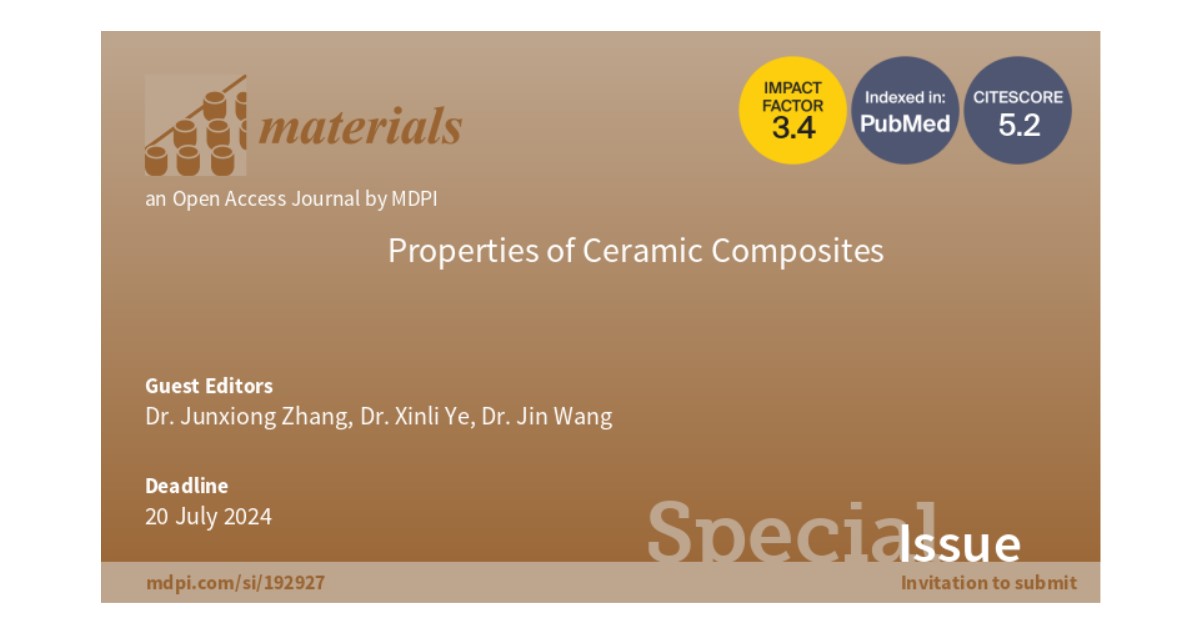- 3.2Impact Factor
- 6.4CiteScore
- 16 daysTime to First Decision
Properties of Ceramic Composites
This special issue belongs to the section “Porous Materials“.
Special Issue Information
Dear Colleagues,
As a kind of key inorganic non-metallic material, ceramic plays a very important role in the development of modern industry. Therefore, the application of ceramic material should be paid attention to focus on. This special issue is focused on the research of ceramic material including but not limited to materials components, fabrication processes, testing equipment and/or methods, applications in thermodynamics, mechanical, electricity, absorption, sound insulation, electromagnetic wave shielding, piezoceramics, and so on. We cordially invite experts in the field of ceramic research to participate in this special issue and contribute manuscripts to us.
https://www.mdpi.com/journal/materials/special_issues/nanomaterials_asia
Dr. Jin Wang
Dr. Xinli Ye
Dr. Junxiong Zhang
Guest Editors
Manuscript Submission Information
Manuscripts should be submitted online at www.mdpi.com by registering and logging in to this website. Once you are registered, click here to go to the submission form. Manuscripts can be submitted until the deadline. All submissions that pass pre-check are peer-reviewed. Accepted papers will be published continuously in the journal (as soon as accepted) and will be listed together on the special issue website. Research articles, review articles as well as short communications are invited. For planned papers, a title and short abstract (about 250 words) can be sent to the Editorial Office for assessment.
Submitted manuscripts should not have been published previously, nor be under consideration for publication elsewhere (except conference proceedings papers). All manuscripts are thoroughly refereed through a single-blind peer-review process. A guide for authors and other relevant information for submission of manuscripts is available on the Instructions for Authors page. Materials is an international peer-reviewed open access semimonthly journal published by MDPI.
Please visit the Instructions for Authors page before submitting a manuscript. The Article Processing Charge (APC) for publication in this open access journal is 2600 CHF (Swiss Francs). Submitted papers should be well formatted and use good English. Authors may use MDPI's English editing service prior to publication or during author revisions.
Keywords
- ceramic matrix composites
- ceramics
- ceramic fiber
- ceramic aerogel

Benefits of Publishing in a Special Issue
- Ease of navigation: Grouping papers by topic helps scholars navigate broad scope journals more efficiently.
- Greater discoverability: Special Issues support the reach and impact of scientific research. Articles in Special Issues are more discoverable and cited more frequently.
- Expansion of research network: Special Issues facilitate connections among authors, fostering scientific collaborations.
- External promotion: Articles in Special Issues are often promoted through the journal's social media, increasing their visibility.
- e-Book format: Special Issues with more than 10 articles can be published as dedicated e-books, ensuring wide and rapid dissemination.

